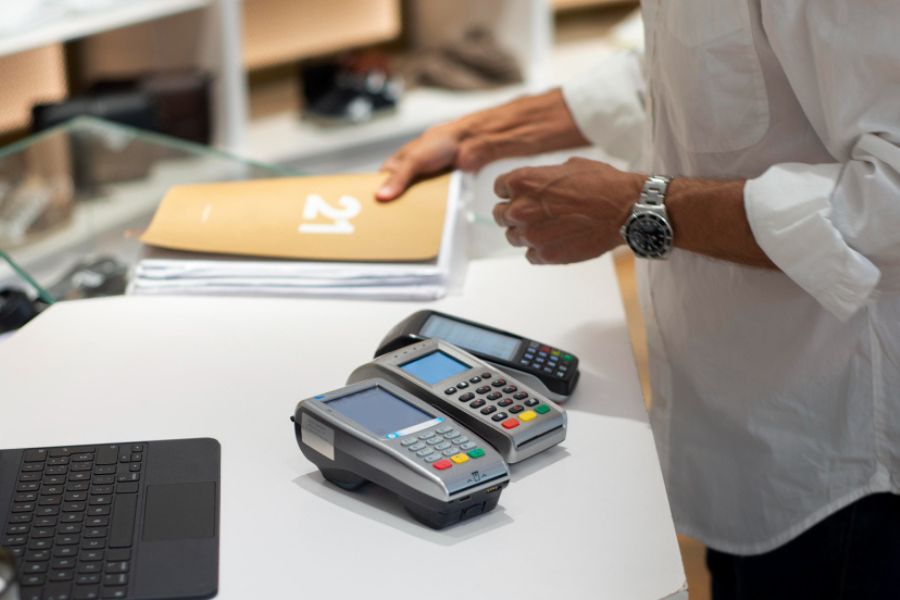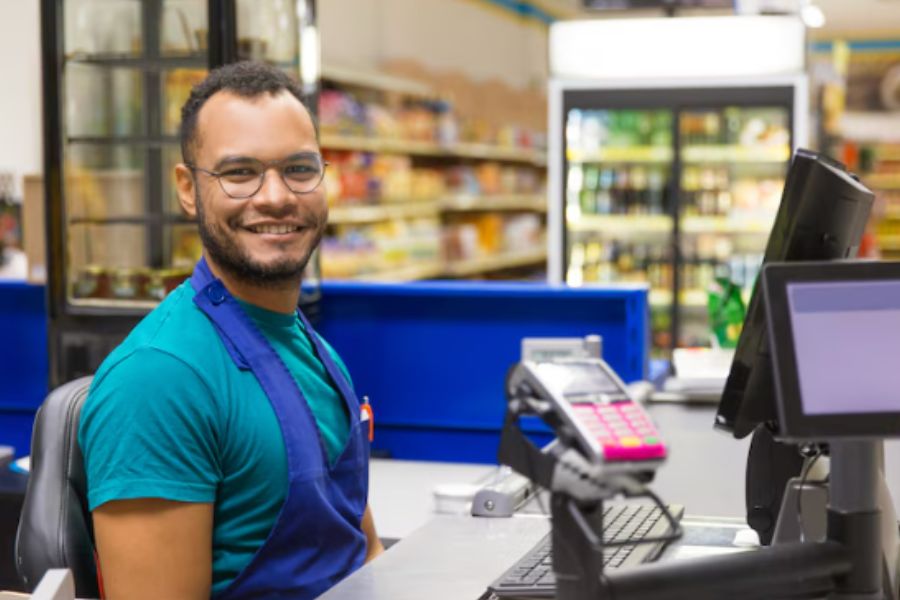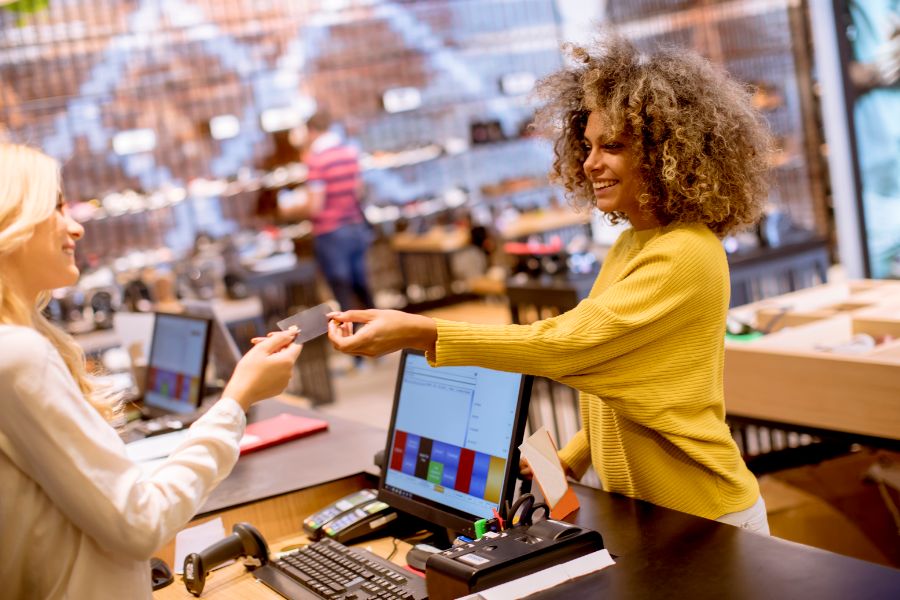Retailers rely on POS systems to shape the customer experience effectively. We may talk about this frequently, but do we all know “what is POS experience in retail” and “what does it encompass?” It’s where technology meets customer service, influencing the entire shopping journey. A well-crafted POS experience can improve satisfaction, encourage loyalty, raise sales, and save costs. This article breaks down the fundamental elements of a successful POS experience in retail and suggests strategies to refine it with a customer-centric approach.
Keep reading!
Highlights
- The POS experience is the integration of technology, processes, and human interaction across the purchasing journey.
- Key components of a POS experience include efficient transactions, personalized interactions, and real-time inventory management to enhance satisfaction.
What is POS Experience in Retail?
The POS experience in retail covers every interaction at the checkout, from how quickly transactions are processed to how easy the system is to use. These factors work together to influence customer satisfaction and loyalty. When the checkout process runs smoothly, it leaves customers with a positive impression, encouraging them to return.
An effective POS system brings together the right technology and processes, allowing staff to focus on serving customers rather than troubleshooting issues. This approach not only improves the shopping experience but also supports a seamless transition from browsing to buying.
Integrable Elements of a Positive POS Experience
A positive POS experience in retail is integral to customer satisfaction and operational efficiency. It encompasses several elements that enhance the checkout process and overall shopping experience.
- User-friendly Interface
An intuitive interface empowers both staff and patrons to navigate the POS system with ease. Its simplicity minimizes training requirements and reduces transaction errors. A clear, well-designed interface accelerates the checkout process, elevating the overall shopping experience.
- Rapid and Accurate Transaction Processing
A POS system that swiftly processes transactions lessens wait times, especially during peak hours. This agility keeps customers content while enabling staff to serve more patrons, potentially increasing sales volume.
- Real-time Inventory Management
Real-time inventory management within the POS system ensures that stock levels are accurately tracked across all sales channels. This capability helps prevent stockouts and overstock situations, allowing retailers to make informed purchasing decisions and maintain optimal inventory levels. It also enables timely restocking of popular items, improving customer satisfaction.
- Integrated Payment Processing
Seamless integration of various payment methods, including credit/debit cards, digital wallets, and cash, is essential for a positive POS experience. Integrated payment processing ensures smooth and secure transactions, reducing the chances of errors and fraud. Offering multiple payment options also caters to diverse customer preferences, enhancing their convenience and satisfaction.
- Customer Relationship Management (POS CRM) Features
CRM features within the POS system facilitate tracking and analyzing customer purchases, preferences, and interactions. This data empowers personalized marketing and targeted promotions, fostering stronger customer relationships. Understanding customer behavior helps retailers tailor offerings to individual needs, nurturing loyalty and repeat business.
Robust reporting and analytics tools provide valuable insights into sales trends, inventory levels, and customer behavior. These insights guide informed decision-making, identify areas for improvement, and support the development of strategies to drive sales and profitability. Accurate reporting also aids financial planning and compliance, ensuring a well-managed retail operation.
Elevating the POS Experience: Strategies for Retailers
Refiningthe point-of-sale (POS) process has a profound impact on customer satisfaction and operational effectiveness. Thus, this section will discuss practical strategies to uplift the POS experience, focusing on efficiency and customer engagement.
Implement Omnichannel POS Solutions with Real-Time Inventory Management
Connecting online and physical sales channels results in a more seamless purchasing experience. An omnichannel POS system combines physical storefronts with eCommerce platforms, providing a single picture of sales and inventories. This technology facilitates services such as Buy Online, Pick Up In-Store (BOPIS), which combine the convenience of online purchases with instant in-store pickup. Such systems enable flexible shopping and synchronize data across all channels, improving inventory management and brand consistency.
For example, Target’s implementation of BOPIS has resulted in increased foot traffic and customer satisfaction, as shoppers appreciate the convenience of picking up online purchases at their local store.
The role of effective inventory management is undeniable in maintaining customer satisfaction and preventing stockouts. Real-time inventory monitoring maintains accurate stock levels, helping to avoid out-of-stock situations. This tracking supports prompt replenishment and better planning. Furthermore, integrating Customer Relationship Management (CRM) systems with POS solutions personalizes customer interactions. CRM systems analyze customer data to tailor promotions and services, enriching the shopping experience and fostering customer loyalty.
Refine the Checkout Process
Improving checkout efficiency involves using technologies like barcode scanning and mobile POS solutions.
Barcode scanning speeds up transactions by eliminating manual entry and reducing errors. Mobile POS systems enable transactions anywhere in the store, cutting down wait times and enhancing customer convenience. An effective checkout process minimizes lines and enriches the shopping experience, potentially increasing customer satisfaction and sales.
We can see that Apple Store employees use mobile POS devices to check out customers anywhere in the store, reducing wait times and enhancing the shopping experience.
Provide a Variety of Payment Options
Accommodating diverse customer preferences requires offering various payment methods. Providing options such as cash, credit/debit cards, and digital wallets ensures convenient payment experiences.
Starbucks exemplifies this by accepting payments through its app, which integrates digital wallets and loyalty programs, making transactions quick and easy for customers.
Introduce Prepaid Store Credit
Prepaid store credits encourage repeat purchases and build customer loyalty. They incentivize customers to return to stores. Linking customer accounts to store credits makes transactions quicker and more convenient. This approach not only promotes customer retention but also refines the checkout process, making it easier for customers to manage and use their credits.
Stores like Best Buy use prepaid gift cards to drive customer retention and repeat visits, as customers are more likely to return to use remaining balances.
Enable Self-Service POS
Introducing self-service kiosks strategically cuts down lines and decreases staff workload. Self-service POS systems enable customers to complete transactions independently, leading to a more effective shopping experience and shorter wait times.
For instance, McDonald’s experienced a notable sales increase after implementing self-service kiosks, showing the potential benefits of this approach. Self-service options give customers greater control over their transactions, contributing to a more satisfying shopping experience.
Manage Loyalty Programs and Promotions Effectively
Managing loyalty programs and promotions through POS systems enhances customer retention and drives repeat business. Automated loyalty programs reward frequent customers and encourage higher spending. POS systems track customer purchases and manage rewards seamlessly, offering personalized promotions and incentives. Automating these processes helps retailers run loyalty programs and promotions efficiently, boosting customer engagement and loyalty.
Retailers like Sephora have successfully used loyalty programs to create personalized customer experiences, resulting in increased engagement and repeat purchases.
Implementing these strategies can greatly improve the POS experience, leading to increased customer satisfaction, smoother operations, and higher sales. Automated loyalty programs and personalized promotions enhance customer engagement and contribute to a more effective retail operation.
ConnectPOS significantly elevates the POS experience by seamlessly linking online and offline sales channels, integrating smoothly with platforms like Magento, WooCommerce, and Shopify. Its customizable interface adapts to various retail environments, allowing businesses to tailor the system to their specific needs. Real-time inventory management ensures accurate stock levels, crucial for meeting customer demands and preventing stockouts. With features like personalized promotions and loyalty programs, ConnectPOS enhances the shopping journey, making it more engaging for customers.
ConnectPOS elevates the retail POS experience by connecting online and physical sales, ensuring a seamless shopping journey. Its adaptable interface lets retailers tailor the system to their specific needs, enhancing customer interactions. The platform’s real-time inventory management keeps stock levels precise, vital for addressing customer demands promptly. Moreover, features such as personalized promotions and loyalty programs enrich the shopping experience, boosting customer satisfaction and engagement.
FAQs: What is POS Experience in Retail?
1. What is a POS experience in retail?
A POS (Point of Sale) experience in retail refers to the customer’s interaction with the checkout process, including the technology and systems used to facilitate transactions. It encompasses the efficiency, speed, and convenience of completing purchases, managing payments, and handling customer service at the point of sale.
2. How can retailers improve their POS experience to benefit both customers and employees?
Retailers can enhance their POS experience by integrating omnichannel solutions, using real-time inventory management, and streamlining checkout with barcode scanning. Offering diverse payment options, introducing self-service kiosks, and running loyalty programs also boost customer satisfaction and operational efficiency.
3. What are some challenges in improving the POS experience that retailers should be aware of?
Challenges include the high cost of upgrading systems, integration complexities, and the need for thorough employee training. Other concerns are potential system downtimes and ensuring data security while adapting to new technologies.
Conclusion
Now you’ve got your answer for “What is POS experience?”. Revitalizing the POS experience breathes new life into the retail journey, transforming mundane transactions into engaging interactions that heighten customer satisfaction. Retailers who prioritize this transformation create a vibrant shopping atmosphere, where both customers and staff connect meaningfully. A dynamic POS system acts as a catalyst for improved service quality, driving business growth and creating memorable shopping experiences. By putting customer needs at the forefront, stores build loyalty and also thrive in a competitive retail landscape.
For more information on how to improve your POS experience with ConnectPOS, feel free to contact us to discuss your specific needs and solutions.



